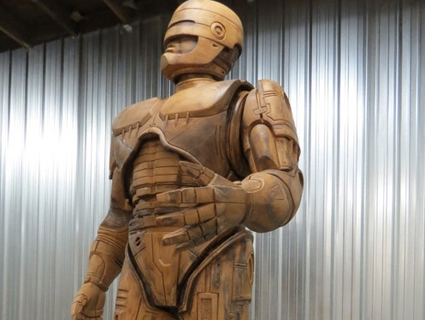
Screenshot: <a href="http://www.kickstarter.com/projects/imaginationstation/detroit-needs-a-statue-of-robocop/posts/479137">Imagination Station Detroit</a>/Kickstarter
Detroit, Michigan, is finally getting its monument to RoboCop.
Last May, photos began circulating online of a giant statue made in honor of the legendary cyborg law enforcer. It’s the result of a Kickstarter campaign by the Imagination Station, a Detroit nonprofit specializing in art and renovation. Three months later, the statue has finally reached Detroit soil.
The model, assembled at Across the Board Creations in British Columbia, arrived Wednesday afternoon in a crate. “Slow and steady wins the race,” Brandon Walley, director of development at the Imagination Station, wrote me earlier this week. But the statue’s journey began long before this summer. The story of how this RoboCop duplicate came into being is a complex two-year saga involving Hollywood executives, political division, gonzo art—and the actual star of RoboCop.
The statue’s origin is, in fact, entirely political. In early 2011, the Democratic Mayor of Detroit and retired NBA Hall of Famer Dave Bing was promoting the Detroit Works Project, an initiative that called for community input to create a “strategic framework plan” for the city. He got the word out on Twitter, which earned him some thoughtful response—and the standard jest. One of the tweeted suggestions came from user @MT, who asked if the city would devote a chunk of its budget to erecting a statue to RoboCop, the eponymous protagonist from Paul Verhoeven’s 1987 action film, which is set in a futuristic, chaotic, and ruined Detroit. (For the uninitiated, the film RoboCop satirizes the excess and horrors of the Reagan era. The character and franchise has since become an American pop-culture icon. A 2014 remake is on the way.)
This is all Mayor Bing had to say about @MT’s modest proposal:
@mt There are not any plans to erect a statue to Robocop.Thank you for the suggestion.
— Mayor Dave Bing (@mayordavebing) February 7, 2011
…which spurred further discussion on the matter:
@mayordavebing Philadelphia has a statue of Rocky & Robocop would kick Rocky’s butt. He’s a GREAT ambassador for Detroit.
— @MT (@MT) February 7, 2011
@mayordavebing @mt While I’d love to see a statue, what about any plans to build an ACTUAL Robocop?
— FuzzHats (@FuzzHats) February 8, 2011
Bing did not entertain the idea of building a fully functional killing machine, either.
In the following days, these frivolous exchanges could have been easily forgotten, reduced to yet another disposable meme. But one evening right before going to sleep, Walley noticed a Facebook page that called for the privately funded construction of a statue, if Mayor Bing refused to act. “The page was created by a friend,” Walley says. “I felt like this was something we had to do. So I called up my partners at the Imagination Station, and we spent the next couple days figuring out if we should, and how we’d do it. It didn’t seem like it would really happen initially—but then it went viral.”
Within 45 days of their Kickstarter and online fundraising campaign, the Imagination Station had raised just shy of $60,000. On their fifth day of fundraising, Walley received a call from Pete Hottelet, the founder of Omni Consumer Products (OCP)—a company named after the evil megacorporation at the center of the RoboCop universe. OCP specializes in selling real-world versions of products seen in popular movies and TV shows—Stay Puft Marshmallows from Ghostbusters, or “Sex Panther” cologne from Anchorman, for instance. Hottelet, who was calling while on an ecology safari in Antarctica, informed him that he had heard about their project and had contacted Mayor Bing’s office to offer his financial and moral assistance. When the mayor’s office rejected his offer (and informed him that the city government wasn’t actually participating in the construction of a RoboCop memorial), he got in touch with the Imagination Station. And when the Kickstarter campaign reached $25,000 on its sixth day, Hottelet said he’d write a check matching the amount. According to Walley, Hottelet remains a significant and enthusiastic part of their RoboCop team.
Hottelet was also helpful when when the Imagination Station was forced to navigate two things with which the OCP founder is quite familiar: The motion picture industry and copyright law. “Pete helped out with the copyright stuff,” Walley says. “We were eventually notified by Metro-Goldwyn-Mayer [the studio that acquired the rights to RoboCop], asking, “Hey, what are you guys doing?’ After a long conversation, they determined that as long as we don’t make any money from this—and don’t sell merchandise—they’re cool with it.” (They continued to regularly hold conference calls with MGM.)
Even before the city of Detroit filed for bankruptcy protection this July (a development that added to RoboCop screenwriter Ed Neumeirer’s case that the dystopia he imagined in the 1980s has come true), the Imagination Station was getting some pushback on the widely publicized project. Some accused the art collective of perpetrating an offbeat distraction while the city endured a financial crisis. “There’s way better use for the money!” people would routinely tell Walley, even though the project was—and still is—a private undertaking. “For every local councilman who says it’s dumb, there’s another enthusiastic one saying they can’t wait,” Walley tells me. “On a small scale, it’s been a politically and socially divisive issue for the past 2 years.”
But the group wasn’t blind to community concerns. “It’s a sensitive issue for some people in Detroit, you know, if the RoboCop statue were to, say, be holding a gun,” Walley says. “We took the time to figure out how we could make it so that this pop-culture icon would be least likely to offend or disturb anyone.” (He will not be packing heat, for example.) And in early 2011, the statue even sparked the creation of “RoboCharity,” which raised money for Oak Park’s Forgotten Harvest Food Bank. The Imagination Station crew pitched in with fundraising and publicity—and hosted an after-party event where actor Peter Weller (the man who played the original RoboCop) swung by for a meet-and-greet. Weller also teamed up with Will Ferrell and Adam McKay’s comedy website Funny or Die to create this video promoting Forgotten Harvest and RoboCharity. He begins the clip by saying how “very touched” he was to hear news of the RoboCop Kickstarter campaign:
The statue has at long last been delivered, via flatbed, to Venus Bronze Works in northeast Detroit, where it will undergo the finishing touches. Here are a couple of photos of the 10-ft.-tall model from May, courtesy of the Kickstarter page:


Those involved expect the next process to last another year, and plan to unveil the statue to the public by August 2014. Still, the location for their RoboCop is up in the air. Plans to display it in TechTown‘s park fell through when the board decided against it. “We have leads and are talking to organizations on a few great final destinations for Robo,” Walley says. Although Walley and his team are documenting the next year-long step for the backers of the project, they’re not ready to let others take a sneak peek. “[We] just want to get it done right with minimal hype until it’s complete,” Walley stresses.
So after tens of thousands of dollars, numerous unexpected hurdles, and a likely total of three years of hard work, the Imagination Station has so far deemed their RoboCop statue “totally worth it.” They’re reminded of why they decided to pursue this whole thing in the first place. “Robocop has become a very suitable icon to represent Detroit, and deserves a place in this city’s history,” their Facebook event page, started over two years ago, still reads. “As Detroit continues to redefine itself into the 21st century—please help to truly make this the coolest city on earth.“
“Yeah, it’s silly,” Walley admits. “But is there no place for 10 feet of silliness within 139 square miles of our expansive city?”
















